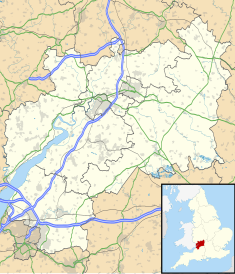Lydney Park is a 17th-century country estate surrounding Lydney House, located at Lydney in the Forest of Dean district in Gloucestershire, England. It is known for its gardens and Roman temple complex.
| Lydney Park | |
|---|---|
 Lydney Park Gardens | |
| Location | Lydney, Gloucestershire, England |
| Coordinates | 51°43′14.52″N 02°33′11.52″W / 51.7207000°N 2.5532000°W |
House and gardens
editLydney Park was bought in 1719 by Benjamin Bathurst, son of the Cofferer of the Household to Queen Anne, and has remained in the family since then. The original house was close to the main road, with a large deer park behind it which was previously part of the estate of White Cross Manor.[1]
In 1875, Rev. William Hiley Bathurst built a new house in the centre of the deer park, with views over the River Severn. The new house was built by C. H. Howell, with a formal garden and shrubberies. The old house was demolished, apart from the buildings now occupied by the Taurus Crafts centre. Rev. Bathurst's grandson Charles, later Viscount Bledisloe, made some further changes to the garden before the house became used in the Second World War, first to house the Dutch royal family and then a girls' school.[2]
The current garden was developed after 1950 by the second Viscount Bledisloe and his family. Betty Fairfax Horsfall was also a involved in the re-design of many areas.[3] There is a woodland garden running along a secluded valley, planted with magnolias, rhododendrons, azaleas and other flowering shrubs. There is a paved terrace above and formal gardens which are popular in the Spring, when the daffodils bloom.[citation needed]
The gardens are private land, and are open to the public on certain days depending on time of year. The house also has a museum containing findings from the Roman site and artefacts from New Zealand collected by the first Viscount Bledisloe.[citation needed]
Archaeological remains
editThe area has an early British Iron Age promontory fort–type hill fort, known as Lydney Camp, covering 4.5 acres. The Romans dug there for iron ore, probably in the 3rd century AD, but apparently abandoned the workings as unproductive.[4] Open-cast iron mines, or scowles, and tunnels still exist throughout the hill.
In the late 4th century, the Romans built a Romano-Celtic temple[5] to Nodens, a Celtic divinity who is reflected by the later figures of Nuada and Nudd/Lludd in Irish and Welsh mythology respectively. Lludd's name survives in the placename of Lydney. Several model dog images have been found there, indicating it was a healing shrine; dogs were associated with such shrines and may have been kept to lick wounds. The structure was a somewhat unusual design, rectangular rather than the usual square Romano-Celtic style temple. The end of the sanctuary or cella was not completely open, as usual; it had three rooms separated by stone walls. The walls of the cella were arched colonnades until a fault in the rock below caused the almost total collapse of the temple. It was rebuilt with solid walls. There was a fish-covered mosaic with an inscription that referred to 'Victorinus the Interpreter', probably an interpreter of dreams. The temple was accompanied by a large courtyard guest house, a long building used as dormitory accommodation and an elaborate bath suite or thermae.[4]
Tessa Wheeler excavated the site between 1928–9 with her husband Mortimer Wheeler [6][7][8] and more excavations took place in 1980–1.[9][10] The finds included a hoard of imitation Roman coins which were thought to date from the 5th century, but are now believed to be 4th century artefacts.[4] The excavation report includes an appendix, "The Name 'Nodens'", written by Oxford philologist J. R. R. Tolkien.[11][12]
References
edit- Wheeler, R.E.M. & T.V. (1932) Report on the excavation of the prehistoric, Roman and post-Roman site in Lydney Park, Gloucestershire. Oxford.
Footnotes
edit- ^ "Lydney Pages 46-84 A History of the County of Gloucester: Volume 5, Bledisloe Hundred, St. Briavels Hundred, the Forest of Dean". British History Online. Victoria County History. Archived from the original on 21 April 2021. Retrieved 2 May 2021.
- ^ Lydney Park - Spring Gardens and Roman Remains, local guidebook (undated)
- ^ Harrison, John. "Historic Aylburton – 6" (PDF). Historic Aylburton. Retrieved 26 August 2021.
- ^ a b c Laing, Jennifer (2008). Snyder, Christopher A. (ed.). Early People of Britain and Ireland: An Encyclopedia, Volume II. Greenwood Publishing Group. p. 373. ISBN 978-1-84645-029-7.
- ^ Located at 51°43′15″N 2°33′29″W / 51.7209°N 2.5580°W
- ^ Report on the Excavation of the Prehistoric, Roman, and Post-Roman Site in Lydney Park, Gloucestershire :(Reports of the Research Committee of the Society of Antiquaries London, No. IX) Wheeler, R. E. M ; Wheeler, T. V. Published by Society of Antiquaries; Research Report No. 9 (1932). https://www.cambridge.org/core/journals/antiquity/article/report-on-the-excavation-of-the-prehistoric-roman-and-postroman-site-in-lydney-park-gloucestershire-by-r-e-m-wheeler-dlit-fsa-and-t-v-wheeler-fsa-pp-viii-137-with-28-textfigures-and-52-plates-reports-of-the-research-committee-of-the-society-of-antiquaries-of-london-no-ix-oxford-printed-at-the-university-press-7s-6d/84117FF8030E1397210FAFEE5627E3D9 Archived 9 June 2018 at the Wayback Machine
- ^ Casey, D.A., 1931. Lydney castle. The Antiquaries Journal, 11(3), pp.240-261. https://www.cambridge.org/core/journals/antiquaries-journal/article/lydney-castle/5B6A742CFC905A29A680178E1E620DE3 Archived 19 June 2018 at the Wayback Machine
- ^ Wheeler, R. E. M.; Wheeler, T. V. (1932). Report on the Excavation of the Prehistoric, Roman, and post-Roman Site in Lydney Park, Gloucestershire. Society of Antiquaries of London. hdl:20.500.12657/50813. ISBN 978-0-85431-219-1.
- ^ Casey, P. J., B. Hoffmann, and J. Dore. "Excavations at the Roman temple in Lydney Park, Gloucestershire in 1980 and 1981." The Antiquaries Journal 79 (1999): 81-143.
- ^ Wright, R. P. "A revised restoration of the inscription on the mosaic pavement found in the temple at Lydney Park, Gloucestershire." Britannia 16 (1985): 248-249.
- ^ "Tolkien's tales from Lydney Park". BBC. Archived from the original on 9 November 2020. Retrieved 13 December 2020.
- ^ "Excavations at Lydney Park Gloucestershire, by R.E.M. Wheeler and T.V. Wheeler". Tolkien Library. Archived from the original on 2 December 2020. Retrieved 13 December 2020.
